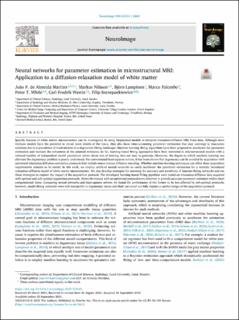| dc.contributor.author | de Almeida Martins, João Pedro | |
| dc.contributor.author | Nilsson, Markus | |
| dc.contributor.author | Lampinen, Björn | |
| dc.contributor.author | Palombo, Marco | |
| dc.contributor.author | While, Peter Thomas | |
| dc.contributor.author | Westin, Carl-Fredrik | |
| dc.contributor.author | Szczepankiewicz, Filip | |
| dc.date.accessioned | 2021-10-04T08:50:02Z | |
| dc.date.available | 2021-10-04T08:50:02Z | |
| dc.date.created | 2021-09-29T14:42:14Z | |
| dc.date.issued | 2021 | |
| dc.identifier.citation | NeuroImage. 2021, 244, . | en_US |
| dc.identifier.issn | 1053-8119 | |
| dc.identifier.uri | https://hdl.handle.net/11250/2787383 | |
| dc.description.abstract | Specific features of white matter microstructure can be investigated by using biophysical models to interpret relaxation-diffusion MRI brain data. Although more intricate models have the potential to reveal more details of the tissue, they also incur time-consuming parameter estimation that may converge to inaccurate solutions due to a prevalence of local minima in a degenerate fitting landscape. Machine-learning fitting algorithms have been proposed to accelerate the parameter estimation and increase the robustness of the attained estimates. So far, learning-based fitting approaches have been restricted to microstructural models with a reduced number of independent model parameters where dense sets of training data are easy to generate. Moreover, the degree to which machine learning can alleviate the degeneracy problem is poorly understood. For conventional least-squares solvers, it has been shown that degeneracy can be avoided by acquisition with optimized relaxation-diffusion-correlation protocols that include tensor-valued diffusion encoding. Whether machine-learning techniques can offset these acquisition requirements remains to be tested. In this work, we employ artificial neural networks to vastly accelerate the parameter estimation for a recently introduced relaxation-diffusion model of white matter microstructure. We also develop strategies for assessing the accuracy and sensitivity of function fitting networks and use those strategies to explore the impact of the acquisition protocol. The developed learning-based fitting pipelines were tested on relaxation-diffusion data acquired with optimal and sub-optimal acquisition protocols. Networks trained with an optimized protocol were observed to provide accurate parameter estimates within short computational times. Comparing neural networks and least-squares solvers, we found the performance of the former to be less affected by sub-optimal protocols; however, model fitting networks were still susceptible to degeneracy issues and their use could not fully replace a careful design of the acquisition protocol. | en_US |
| dc.language.iso | eng | en_US |
| dc.publisher | Elsevier Science | en_US |
| dc.relation.uri | https://www.sciencedirect.com/science/article/pii/S1053811921008740 | |
| dc.rights | Attribution-NonCommercial-NoDerivatives 4.0 Internasjonal | * |
| dc.rights.uri | http://creativecommons.org/licenses/by-nc-nd/4.0/deed.no | * |
| dc.title | Neural networks for parameter estimation in microstructural MRI: application to a diffusion-relaxation model of white matter | en_US |
| dc.type | Peer reviewed | en_US |
| dc.type | Journal article | en_US |
| dc.description.version | publishedVersion | en_US |
| dc.source.pagenumber | 12 | en_US |
| dc.source.volume | 244 | en_US |
| dc.source.journal | NeuroImage | en_US |
| dc.identifier.doi | 10.1016/j.neuroimage.2021.118601 | |
| dc.identifier.cristin | 1940671 | |
| dc.relation.project | Norges forskningsråd: 302624 | en_US |
| dc.source.articlenumber | 118601 | en_US |
| cristin.ispublished | true | |
| cristin.fulltext | original | |
| cristin.qualitycode | 2 | |

